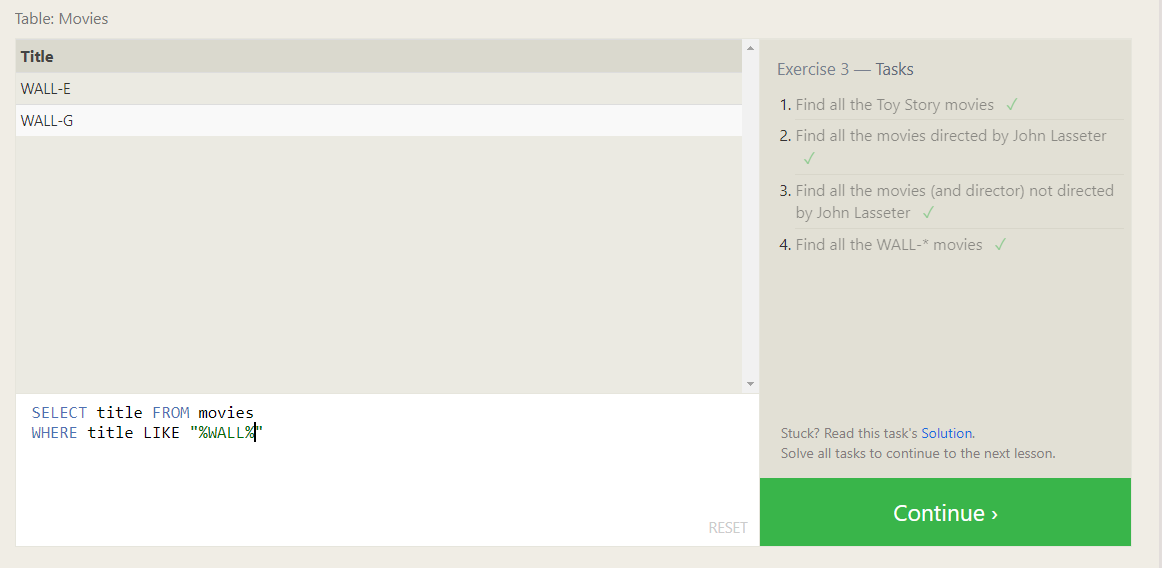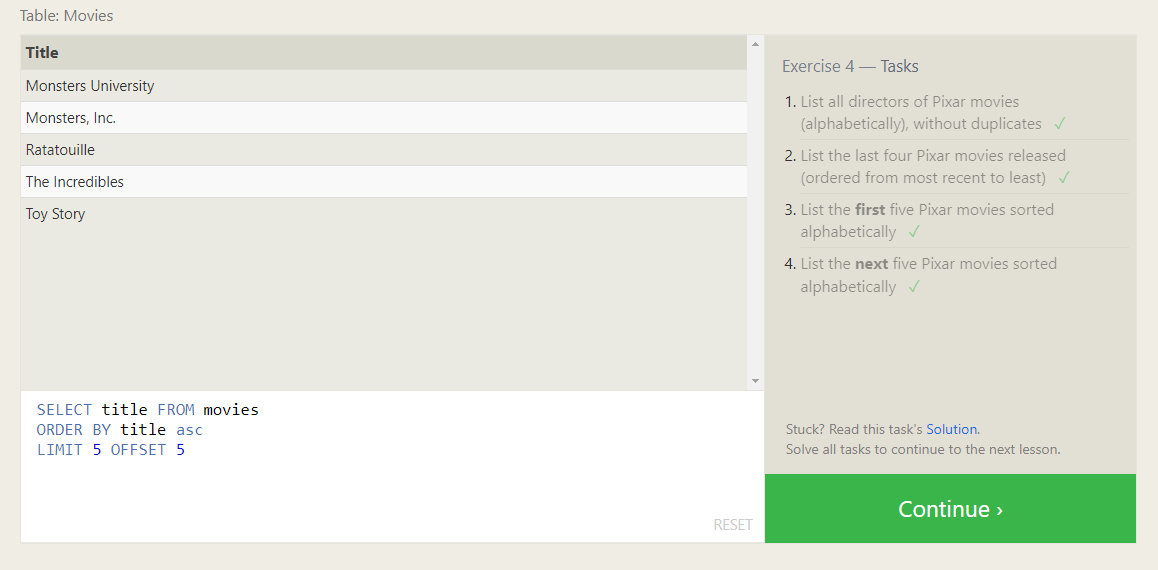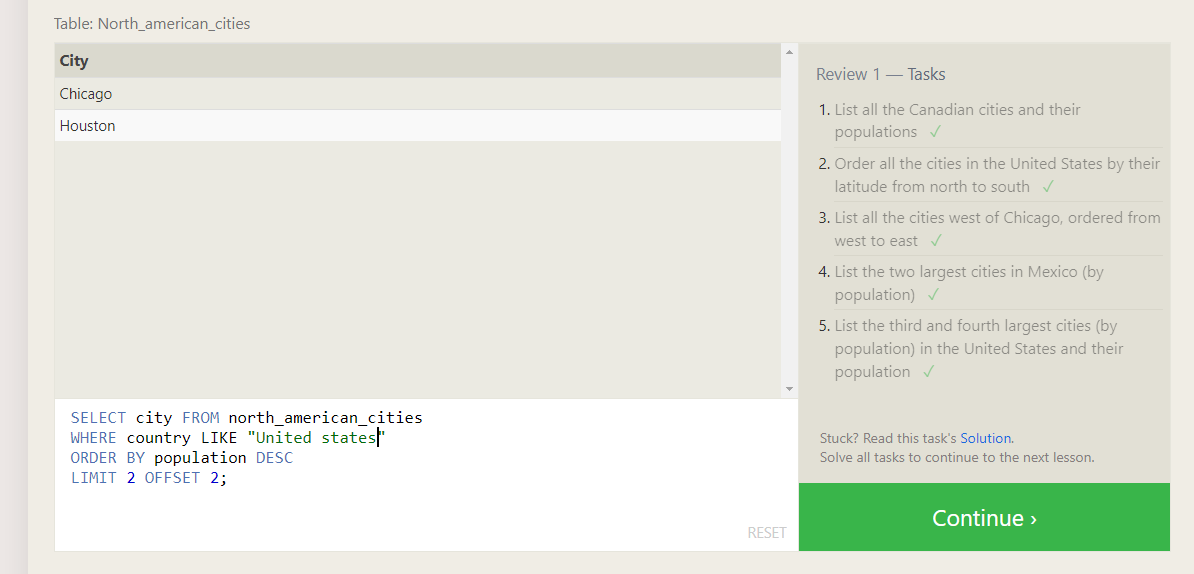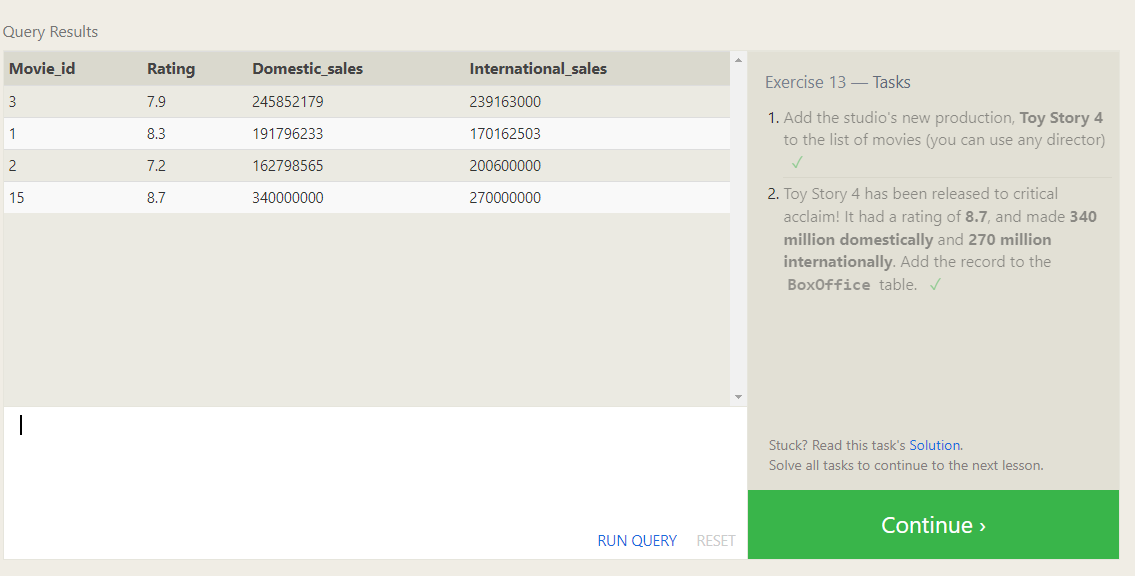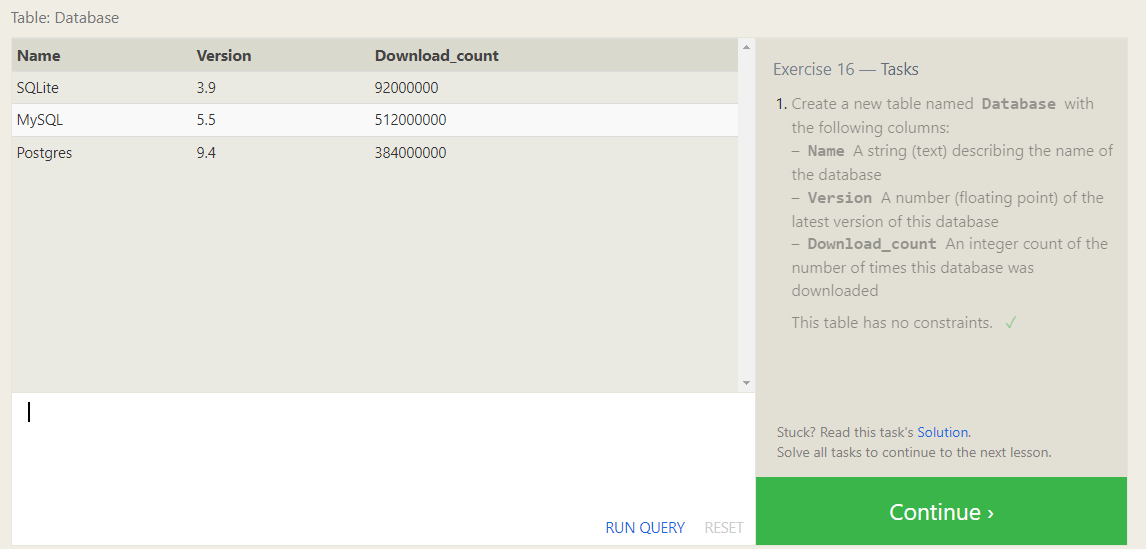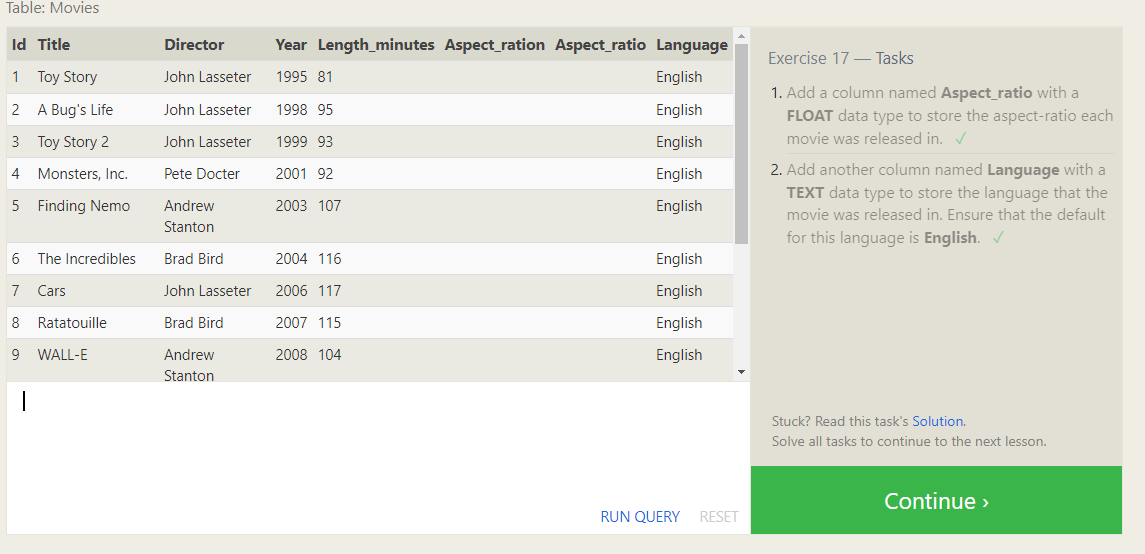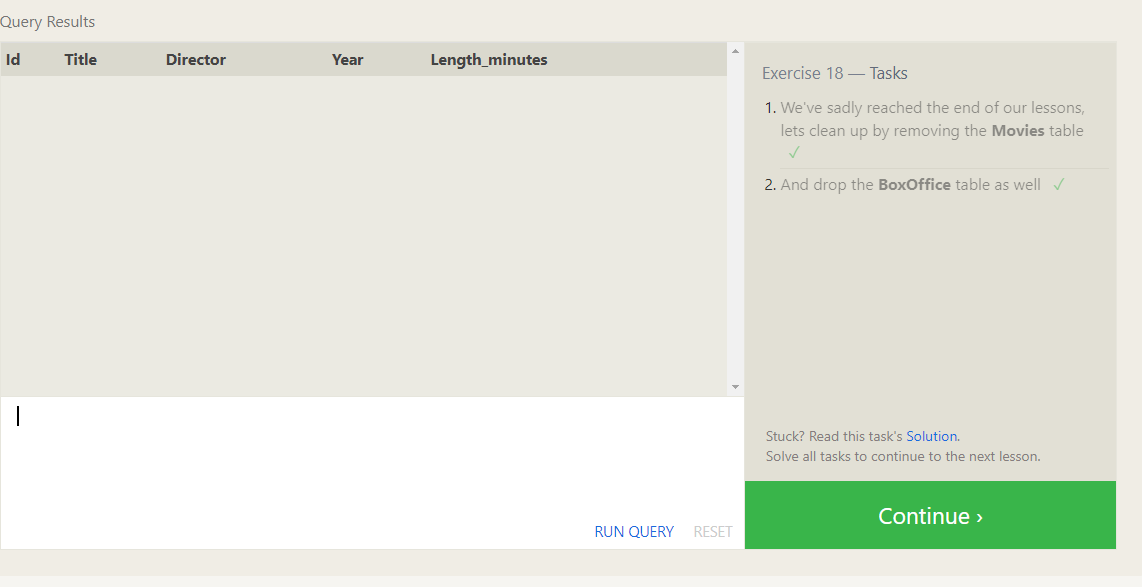reading-notes
Learn SQL
References
Notes
Learn SQL
- SQL databases are composed of tables, columns and rows of data similar to a spreadsheet
- These tables all have relationships that can be defined by the user
SQL Bolt
- Assignment
- Lessons 1 through 6 - SQL Queries
- Lessons 13 through 18 - Database Management
Basic Commands
SELECT- Retrieves data from the database
SELECTdefines the data to returnFROMdefines the table to look inside*selector will return all columns
SELECT column, another_column, ... FROM mytable;WHERE- Adds conditional logic to query
- Allows us to filter out unwanted data
SELECT column, another_column, … FROM mytable WHERE condition AND/OR another_condition AND/OR …;Operator Condition SQL Example =, !=, < <=, >, >= Standard numerical operators col_name != 4 BETWEEN … AND … Number is within range of two values (inclusive) col_name BETWEEN 1.5 AND 10.5 NOT BETWEEN … AND … Number is not within range of two values (inclusive) col_name NOT BETWEEN 1 AND 10 IN (…) Number exists in a list col_name IN (2, 4, 6) NOT IN (…) Number does not exist in a list col_name NOT IN (1, 3, 5) = Case sensitive exact string comparison (notice the single equals) col_name = “abc” != or <> Case sensitive exact string inequality comparison col_name != “abcd” LIKE Case insensitive exact string comparison col_name LIKE “ABC” NOT LIKE Case insensitive exact string inequality comparison col_name NOT LIKE “ABCD” % Used anywhere in a string to match a sequence of zero or more characters (only with LIKE or NOT LIKE) col_name LIKE “%AT%” (matches “AT”, “ATTIC”, “CAT” or even “BATS”) _ Used anywhere in a string to match a single character (only with LIKE or NOT LIKE) col_name LIKE “AN_” (matches “AND”, but not “AN”) IN (…) String exists in a list col_name IN (“A”, “B”, “C”) NOT IN (…) String does not exist in a list col_name NOT IN (“D”, “E”, “F”) DISTINCT- Removes duplicate values
SELECT DISTINCT column, another_column, … FROM mytable WHERE condition(s);ORDER BY- Sorts data in specified order
SELECT column, another_column, … FROM mytable WHERE condition(s) ORDER BY column ASC/DESC;LIMIT/OFFSETLIMITreduces the number of rows to returnOFFSETspecifies where to begin counting the number of rows from
SELECT column, another_column, … FROM mytable WHERE condition(s) ORDER BY column ASC/DESC LIMIT num_limit OFFSET num_offset;- Multi-table queries with JOINs
- In order to answer questions about an entity that has data spanning multiple tables in a normalized database, we need to learn how to write a query that can combine all that data and pull out exactly the information we need.
INNER JOIN- Matches rows from teh first table and the second table which have the same key (as defined by the ON constraint) to create a new result row with the combined columns from both tables
SELECT column, another_table_column, … FROM mytable INNER JOIN another_table ON mytable.id = another_table.id WHERE condition(s) ORDER BY column, … ASC/DESC LIMIT num_limit OFFSET num_offset; INSERT- Inserts rows into table
- Can insert into all columns or add specific columns as defined in the query
INSERT INTO mytable (column, another_column, …) VALUES (value_or_expr, another_value_or_expr, …), (value_or_expr_2, another_value_or_expr_2, …), …;UPDATE- Updates the values within a table
UPDATE mytable SET column = value_or_expr, other_column = another_value_or_expr, … WHERE condition;DELETE- Deletes rows in specific columns with or without criteria
DELETE FROM mytable WHERE condition;CREATE TABLE- Creates a new table to store in the database
CREATE TABLE IF NOT EXISTS mytable ( column DataType TableConstraint DEFAULT default_value, another_column DataType TableConstraint DEFAULT default_value, … );-
Table Data Types
Data type Description INTEGER, BOOLEAN The integer datatypes can store whole integer values like the count of a number or an age. In some implementations, the boolean value is just represented as an integer value of just 0 or 1. FLOAT, DOUBLE, REAL The floating point datatypes can store more precise numerical data like measurements or fractional values. Different types can be used depending on the floating point precision required for that value. CHARACTER(num_chars), VARCHAR(num_chars), TEXT The text based datatypes can store strings and text in all sorts of locales. The distinction between the various types generally amount to underlaying efficiency of the database when working with these columns. Both the CHARACTER and VARCHAR (variable character) types are specified with the max number of characters that they can store (longer values may be truncated), so can be more efficient to store and query with big tables. DATE, DATETIME SQL can also store date and time stamps to keep track of time series and event data. They can be tricky to work with especially when manipulating data across timezones. BLOB Finally, SQL can store binary data in blobs right in the database. These values are often opaque to the database, so you usually have to store them with the right metadata to requery them.
-
Table Constraints
Constraint Description PRIMARY KEY This means that the values in this column are unique, and each value can be used to identify a single row in this table. AUTOINCREMENT For integer values, this means that the value is automatically filled in and incremented with each row insertion. Not supported in all databases. UNIQUE This means that the values in this column have to be unique, so you can’t insert another row with the same value in this column as another row in the table. Differs from the PRIMARY KEYin that it doesn’t have to be a key for a row in the table.NOT NULL This means that the inserted value can not be NULL.CHECK (expression) This allows you to run a more complex expression to test whether the values inserted are valid. For example, you can check that values are positive, or greater than a specific size, or start with a certain prefix, etc. FOREIGN KEY This is a consistency check which ensures that each value in this column corresponds to another value in a column in another table. For example, if there are two tables, one listing all Employees by ID, and another listing their payroll information, the FOREIGN KEYcan ensure that every row in the payroll table corresponds to a valid employee in the master Employee list. ALTER TABLE- Used to preface commands to modify the table
ADD- Adds columns to the table
ALTER TABLE mytable ADD column DataType OptionalTableConstraint DEFAULT default_value;DROP- Deletes a column
ALTER TABLE mytable DROP column_to_be_deleted;RENAME- Changes a column header
ALTER TABLE mytable RENAME TO new_table_name;
DROP TABLE- Removes an entire table given certain criteria
DROP TABLE IF EXISTS mytable;
Screenshots


